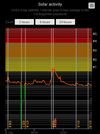SOLAR CYCLE 25 ACTIVITY REPORT SEP 28
Solar activity continues at low levels with 14 observed C class flares. The largest event of the period was a C5 flare, occurred at 19:50 UTC on September 27 from AR3105, the most active region.
There are currently 4 numbered active regions on the disk: AR3105, AR3107, AR3110, and new region AR3111
AR3111 is a sunspot located on the northeast (N27E62) with an area of 100MH and a alfa magnetic configuration. It does not represent a threat of large eruptions.
The total number of sunspots decreased to 110. NOAA forecast for the next 24h is 90% chance for C flares, 25% chance for M flares and 5% chance for X flares.
▪︎Auroral Activity
The geomagnetic field has been at quiet to unsettled levels for the past 24 hours. Solar wind speed reached a peak of 573 km/s at 09:23 UTC on September 28
Current Conditions at 11:30 UTC on September 28
▪︎Geospace quiet
▪︎Geomagnetic conditions now KP=1
▪︎Solar wind speed record: 540.1 km/sec
▪︎density: 9.55 protons/cm3
▪︎Neutron Counts today: +0.1% Average
▪︎X-ray Solar Flare: C1 at 07:53 UTC
▪︎Sunspot number: 110 (SN 120 Sep 27)
SpaceWeatherlive..com
SpaceWeather.com
EarthSky.com
Solar activity continues at low levels with 14 observed C class flares. The largest event of the period was a C5 flare, occurred at 19:50 UTC on September 27 from AR3105, the most active region.
There are currently 4 numbered active regions on the disk: AR3105, AR3107, AR3110, and new region AR3111
AR3111 is a sunspot located on the northeast (N27E62) with an area of 100MH and a alfa magnetic configuration. It does not represent a threat of large eruptions.
The total number of sunspots decreased to 110. NOAA forecast for the next 24h is 90% chance for C flares, 25% chance for M flares and 5% chance for X flares.
▪︎Auroral Activity
The geomagnetic field has been at quiet to unsettled levels for the past 24 hours. Solar wind speed reached a peak of 573 km/s at 09:23 UTC on September 28
Solar wind flowing from this double equatorial coronal hole should graze Earth's magnetic field on Oct 1-2.MORE AURORAS. After yesterday’s unexpected G2 (moderate) geomagnetic storm, conditions for G1 (minor) and the chance for more aurora continues. Spectacular aurora observations continue from the northern US, Canada, and northern Europe. EarthSky.com
Current Conditions at 11:30 UTC on September 28
▪︎Geospace quiet
▪︎Geomagnetic conditions now KP=1
▪︎Solar wind speed record: 540.1 km/sec
▪︎density: 9.55 protons/cm3
▪︎Neutron Counts today: +0.1% Average
▪︎X-ray Solar Flare: C1 at 07:53 UTC
▪︎Sunspot number: 110 (SN 120 Sep 27)
SpaceWeatherlive..com
SpaceWeather.com
EarthSky.com





